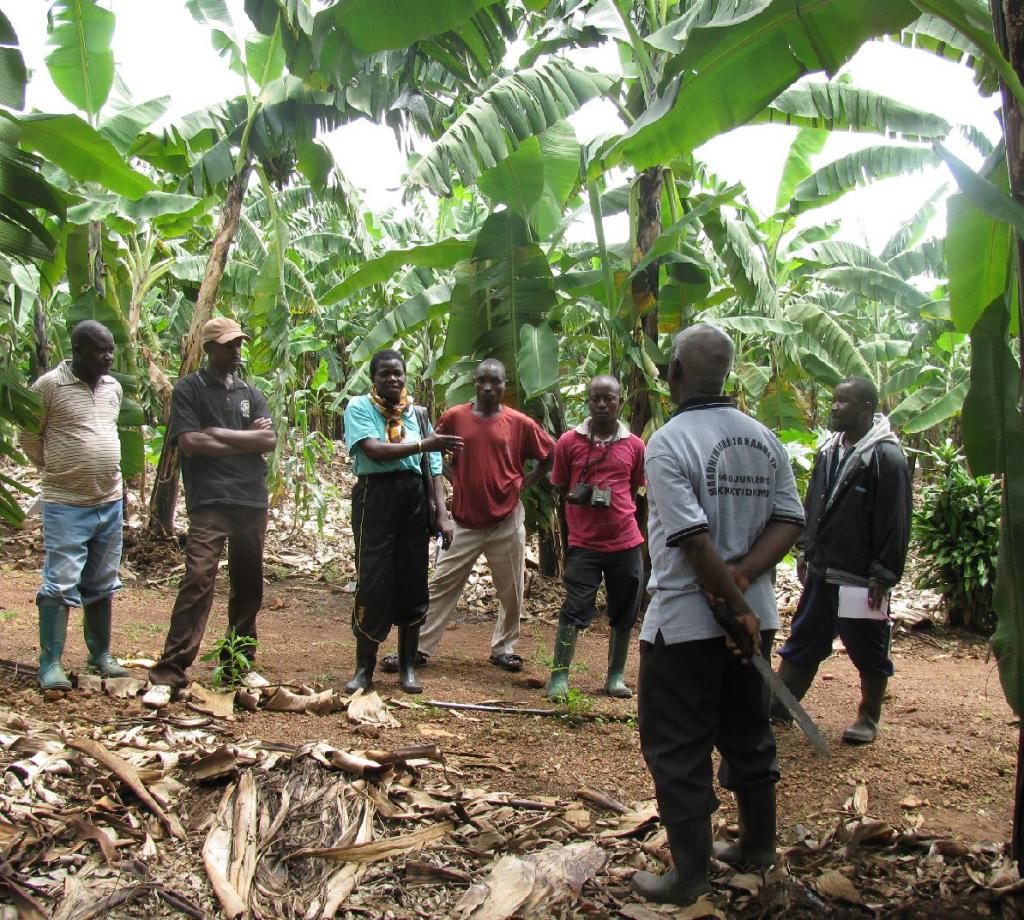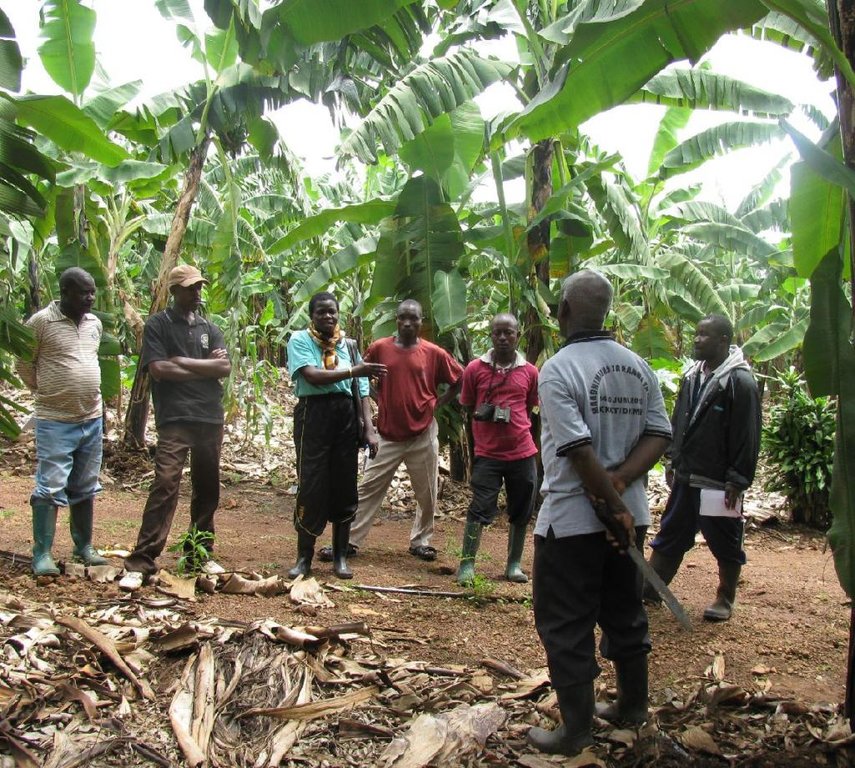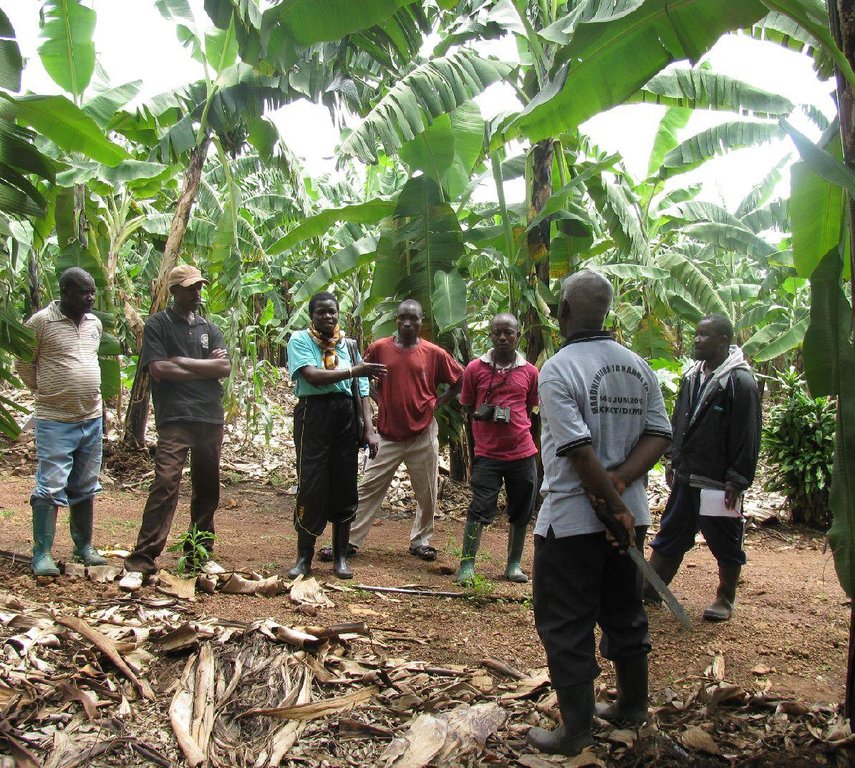Integrated farm knowledge adoption [República Unida da Tanzânia]
- Criação:
- Atualização:
- Compilador/a: Jasson Rwazo
- Editor: –
- Revisor: Fabian Ottiger
Tweyambe
approaches_2677 - República Unida da Tanzânia
Veja as seções
Expandir tudo Recolher tudo1. Informação geral
1.2 Detalhes do contato das pessoas capacitadas e instituições envolvidas na avaliação e documentação da abordagem
1.3 Condições em relação ao uso da informação documentada através de WOCAT
Quando os dados foram compilados (no campo)?
11/07/2012
O/a compilador/a e a(s) pessoa(s) capacitada(s) aceitam as condições relativas ao uso de dados documentados através da WOCAT:
Sim
1.4 Referência ao(s) questionário(s) sobre tecnologias da GST

Improved Kibanja cropping system [República Unida da Tanzânia]
This is a traditional banana and coffee complex cropping system interplanted with annual crops, trees,shrubs, vegetables and other diverse plants of social economic importance.
- Compilador/a: Jasson Rwazo
2. Descrição da abordagem de GST
2.1 Descrição curta da abordagem
The way and means through which a performing farmers adopt and use a combination of indigenous and scientific to maximaze production.
2.2 Descrição detalhada da abordagem
Descrição detalhada da abordagem:
Aims / objectives: To adopt and combine indigenous (traditional) and Scientific knowledge in Kibanja system to improve farm productivity through soil and water use efficiency.
Methods: Continuous adoption of indigenous knowledge through story telling and experience
Adoption of technical knowledge extension officers, knowledgeable farmers, projects and research agencies
Implementing the adopted knowledge to the farm
Stages of implementation: Area identification
Area planned phased and rehabilitation and mitigation
Continuous monitoring and supervision to prevent degradation
Introduce small and large stock for manure production
Role of stakeholders: Land user: Promote and use the technology
Community:Maine implementor of the technology,Source of labour
Extension and research:Provision of technical advise
Financial institution for financial capital support
Clan/Family: Family labour
Other important information: Though land ownership is through customary law, but approach is used by both gender, all family members benefit equally from the use of the approach.
Application of this approach needs integrative and proper conceptual understanding of both indigenous and
2.3 Fotos da abordagem
2.5 País/região/locais onde a abordagem foi aplicada
País:
República Unida da Tanzânia
Região/Estado/Província:
Kagera
Especificação adicional de localização:
Missenyi
2.7 Tipo de abordagem
- Integrated knowledge adoption(traditional,innovative,project)
2.8 Principais metas/objetivos da abordagem
The Approach focused mainly on SLM with other activities (Improvement of house hold food security and income)
To improve agricultural production and productivity
Sustainable utilization of land and water
To minimize loss during adverse condition (drought/Wind)
To improve house hold food security,income and livelihood
The SLM Approach addressed the following problems: Low agricultural production
Inadequate complementary use of indigenous and technical knowledge
Poor livelihood and income
2.9 Condição que propiciam ou inibem a implementação de tecnologia/tecnologias aplicada(s) segundo a abordagem
Disponibilidade/acesso a recursos e serviços financeiros
- Inibitivo
Inadequate financial capital
Treatment through the SLM Approach: Phase/Stepwise rehabilitation and expansion
Introducing saving and credit scheme through village bank
Conhecimento sobre GST, acesso a suporte técnico
- Inibitivo
Lack of proper integration of indigenous scientific knowledge
Treatment through the SLM Approach: Research
Carga de trabalho, disponibilidade de força de trabalho
- Inibitivo
Lab our intensive
Treatment through the SLM Approach: To modernize the technology to allow mechanisation
3. Participação e papel das partes interessadas envolvidas
3.1 Partes interessadas envolvidas na abordagem e seus papéis
- Usuários de terra/comunidades locais
Land user and casual labour
Approach requires capita
- Pesquisadores
Research institute
Caso várias partes interessadas foram envolvidas, indique a agência líder:
Elders developed the approach through trial and error
3.2 Envolvimento do usuários de terra/comunidades locais nas diferentes fases da abordagem
| Envolvimento do usuários de terra/comunidades locais | Especifique quem estava envolvido e descreva as atividades | |
|---|---|---|
| Iniciação/motivação | Automobilização | Land user and his family |
| Planejamento | Automobilização | Land user and his family |
| Implementação | Automobilização | Land user and his family |
| Monitoramento/avaliação | Automobilização | Land user and his family |
| Research | Automobilização | Land user and his family |
3.4 Decisão sobre a seleção de tecnologia/tecnologias de GST
Especifique quem decidiu sobre a seleção de tecnologia/tecnologias a serem implementadas:
- Somente usuários da terra (iniciativa própria)
Explique:
The land user through his own initiative basing on experience and interaction with other land user and experts decide on the proper technology to use
Decisions on the method of implementing the SLM Technology were made by by land users* alone (self-initiative / bottom-up). The land user through his own initiative basing on experience and interaction with other land user and experts decide on the proper technology to implementation of the technology
5. Financiamento e apoio material externo
5.1 Orçamento anual para o componente de GST da abordagem
Caso o orçamento exato seja desconhecido, indique a faixa:
- 2.000-10.000
Comentários (p. ex. principais fontes de recursos/principais doadores):
Approach costs were met by the following donors: local community / land user(s) (Land user on his own): 100.0%
6. Análise de impactos e declarações finais
6.1 Impactos da abordagem
A abordagem auxiliou os usuários da terra a implementar e manter as tecnologias de GST?
- Não
- Sim, pouco
- Sim, moderadamente
- Sim, significativamente
Increase of the size of banana bunch, control of erosion and soil nutrient loss
A abordagem concedeu autonomia aos grupos social e economicamente desfavorecidos?
- Não
- Sim, pouco
- Sim, moderadamente
- Sim, significativamente
Did other land users / projects adopt the Approach?
- Não
- Sim, pouco
- Sim, moderadamente
- Sim, significativamente
Did the Approach lead to improved livelihoods / human well-being?
- Não
- Sim, pouco
- Sim, moderadamente
- Sim, significativamente
Did the Approach help to alleviate poverty?
- Não
- Sim, pouco
- Sim, moderadamente
- Sim, significativamente
7. Referências e links
7.1 Métodos/fontes de informação
- visitas de campo, pesquisas de campo
- entrevistas com usuários de terras
Links e módulos
Expandir tudo Recolher tudoLinks

Improved Kibanja cropping system [República Unida da Tanzânia]
This is a traditional banana and coffee complex cropping system interplanted with annual crops, trees,shrubs, vegetables and other diverse plants of social economic importance.
- Compilador/a: Jasson Rwazo
Módulos
Não há módulos




